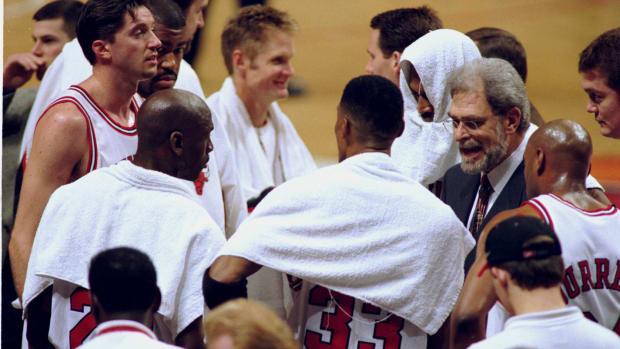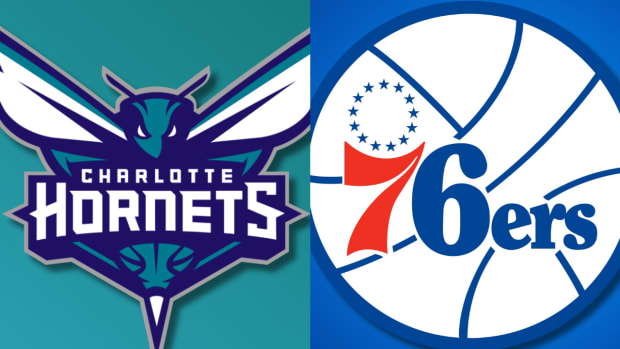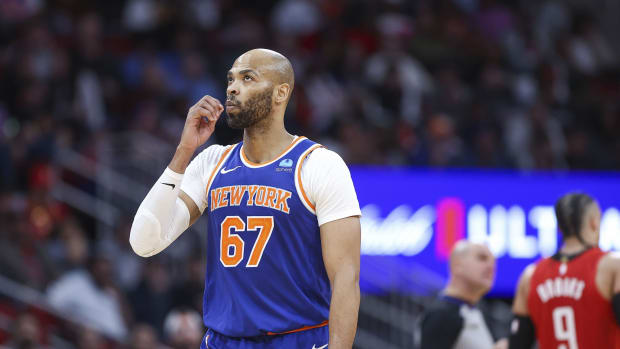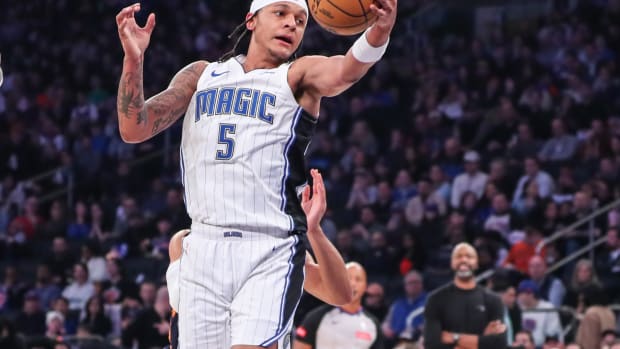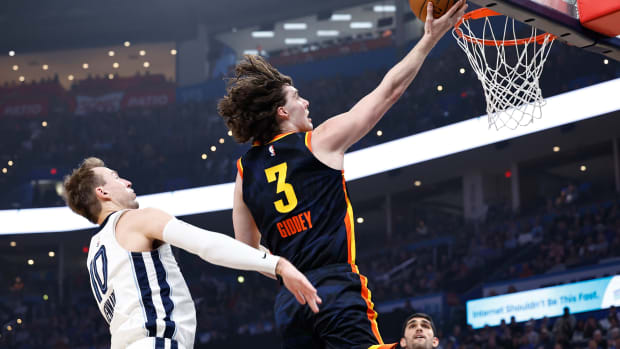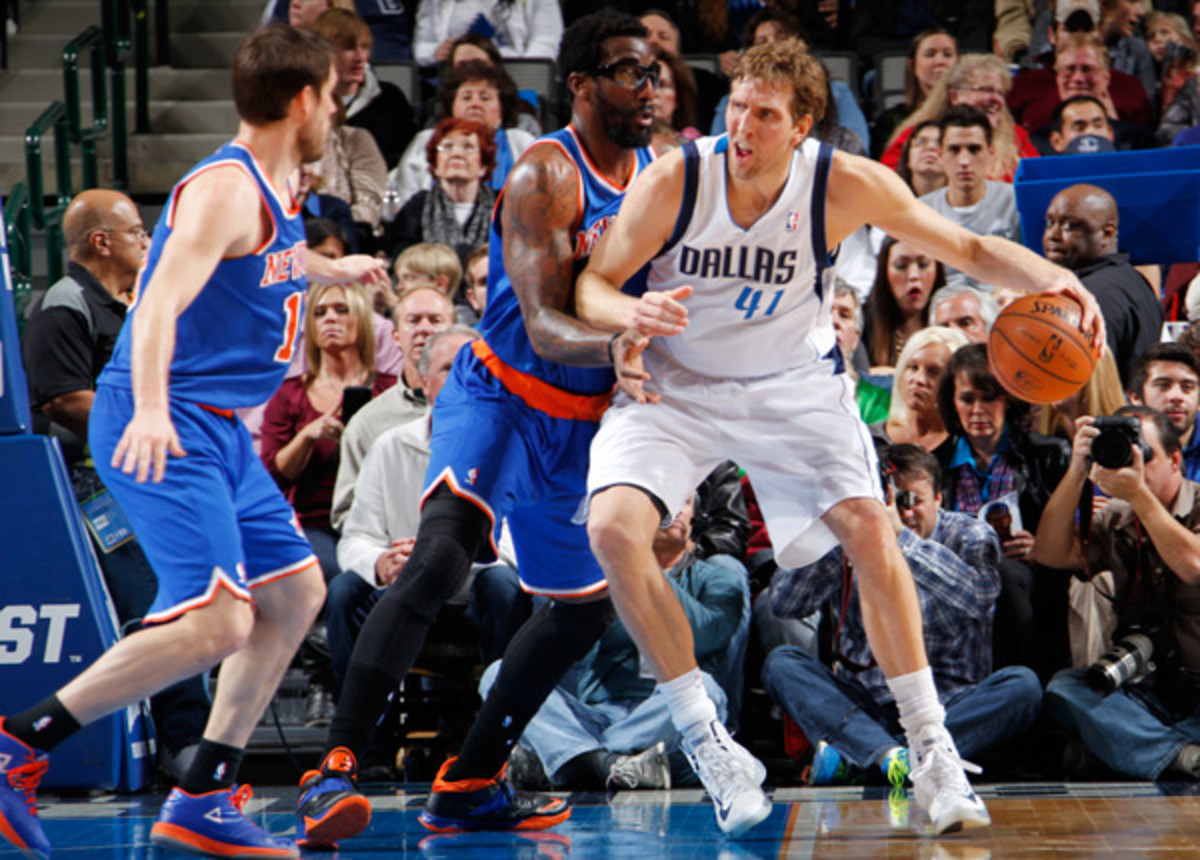
The Fundamentals: Why Dirk Nowitzki still means everything for evolving Mavs
Dirk Nowitzki has become a master of exploiting double teams in the post. (Glenn James/NBAE/Getty Images)
The Mavericks go to great and impressive lengths to camouflage their simplicity. What is ultimately a fairly basic pick-and-roll offense is established by preliminary action -- screens and the like intended to get the defense thinking and moving away from what's to come. The intended device is the same whether its employed by teams from the NBA's elite or squads from your local rec league, though the quality of its practitioners and the scripted setting Dallas employs aid in making the simple sophisticated.
Defensively, head coach Rick Carlisle does everything in his power to address his team's limitations. Cross-matching is more or less guaranteed, as every game seems to present unique challenges in coverage. There are touches of zone (sometimes out of choice, sometimes out of desperation), scheduled help rotations from all angles, and a wide range of methods indicative of a well-prepared team.
Yet none of it is enough to disguise what is most simply evident: These Mavericks will only go as far as their offense takes them.
That statement, even still, brings Dirk Nowitzki into focus. Dallas restructured its roster this season to bring Nowitzki more help -- most notably from a pair of ball handlers of very different talents and basketball worldviews. In Monta Ellis, the Mavs acquired a much-needed dribble penetrator, capable of compromising defenses from within. In Jose Calderon, Dallas found a lethal perimeter marksman and heady, low-risk orchestrator from without. The pair contrasts beautifully on offense, though even at their best seem to only reinforce Nowitzki's value as an offensive centerpiece; for all that Ellis and Calderon offer as shot creators, the 35-year-old Nowitzki remains the bridge between them, and the true, efficient engine behind one of the league's very best offenses.
GIVE AND GO: Best calls, worst mistakes of SI's Top 100 players of 2014 list
That Nowitzki remains a focal point has less to do with touches or field goal attempts than general function. Dallas now has the luxury of leaning on Ellis, Calderon, or Vince Carter to conjure offense off the bounce. But working off of Dirk in the high pick-and-roll and/or the post (for the Mavs, one play type can quickly morph into the other) is nonetheless at the crux of how the Mavs operate -- to say nothing of his influence even as a weak-side accessory. Rare are players of Nowitzki's offensive prowess, a fact which Carlisle and the Mavericks on the whole seem to understand fully.
In that, the team's offense typically courses its way through Nowitzki in some fashion. The most obvious is an outright score, an area of the game in which Dirk still works from a place of inevitability. Some defenders manage to bother him more than others, but there's only so much that can be done in waving at the high release point of a lofting jumper. With better teammates and a healthy entrance to the season, Nowitzki has posted three-year highs in per-minute scoring and effective field goal percentage, all behind a usage rate just a few ticks shy of his prime levels. All this in what is his 13th season as a first-option scorer, having logged over 46,000 NBA minutes. The man is a marvel.
JENKINS: Time for renovating Lakers to part ways with Pau Gasol
Over the weekend, Dirk dropped 40 points in just 34 minutes against the Pelicans, in the process becoming the sixth-oldest player in NBA history to reach that particular scoring benchmark. Ho-hum for an ageless wonder, for whom the very act of anchoring an offense has become second nature. It's in that regard that Nowitzki separates himself most fully; there are talented scorers all over the league, some of whom put up points efficiently. Yet what makes Nowitzki perfect for offensive ballast is his combination of accessibility and pliability, particularly in the face of defensive pressure.
Seasons in which Darren Collison and O.J. Mayo are Dallas' lead guards excluded, getting the ball in to Dirk is rarely a problem, even under duress. He's quick to adjust when a particular placement isn't working, and actively helps his ball-handling teammates to create workable entry pass angles. On top of that, Nowitzki gets a ton of respect from officials when fighting for post position; that vehicle alone is typically good for a foul call or two per game, allowing Dallas to reset its offense while drawing another team foul toward the bonus.
In all, that makes Nowitzki an easy target for necessary possessions -- those moments when Dallas needs to boost its lead, tie the game, or stave off a run with a high-percentage look. Of course, getting Dirk possession of the ball often only introduces the next challenge: Nowitzki is so consistently potent in one-on-one situations that he sees added defensive pressure regularly. There's a dramatic difference between having the ability to draw double teams and having the wherewithal to exploit them, and it's in that distinction that Nowitzki has thrived as an offensive hub.
"You know, you've gotta see what's out there," Nowitzki said. "I hit the cutter a couple times [in Monday's game against Orlando] -- guys did a good job cutting at the right moment. If the cut's not there, you usually swing, swing, and the way you beat the double team is on the weak side. If there's a shooter open, or if they run at the shooter, you've gotta show and go, get in the lane and create some stuff.
"It's all about getting the ball out without a turnover. [Earlier in my career], I did turn the ball over more [in double-team situations] than I do now, but you've just gotta be smart with it. Sometimes even the most simple pass out of a double team is the best one. You can try to thread the needle to a shooter on the weak side and that's the one that gets intercepted when you should have just passed it out and let someone else make the play. So you learn with experience that the easiest pass is sometimes the best one."
DOLLINGER: Mavericks up to No. 9 in this week's Power Rankings
That simple kick-out that Nowitzki describes is a more reluctant play for many star scorers than it should be. There's a clear temptation to play out of double teams in a way that earns the shot-creator credit -- whether in hitting a difficult shot over two defenders or making the pass that leads directly to the score. But Dirk's redirection of the offense generally goes to the best option available, be it a cutter in position or merely a perimeter teammate who can make the next play in the sequence. As a result, even his assists tend to be unspectacular, though completely essential to Dallas' offensive stability:
If Nowitzki weren't able or willing to make the most straightforward pass out of pressure situations, Dallas wouldn't have won the 2011 title, wouldn't have gone on a run of 11-straight 50-win seasons with Dirk as a primary contributor, and wouldn't be able to subsist in its current form. That simple act -- which, to be fair, is far more challenging than it seems -- is elevating and steadying on a systemic level. It has been the basis for so many Maverick points since Nowitzki's emergence, and it's a dimension of his game for which Dirk is rarely given enough credit. Working from the post against modern NBA defenses is incredibly tricky as it is, yet Nowitzki manages to make use of that space while shooting an impossible percentage and barely committing any turnovers at all.
Other post threats power into offensive fouls, stumble into travels, or fret against oncoming doubles. Nowitzki does none of the above, and as a result outclasses most of the low-post elite. Look at how he measures up in efficiency against some of the league's other prolific post-up threats, courtesy of Synergy Sports:
***
Above stats regard post-up situations specifically. "PPP" is points scored per play in the post, accounting for field goals made and missed, turnovers committed, and shooting fouls drawn.
It's not by coincidence that Nowitzki's strengths -- efficient shooting from the field and a low turnover percentage -- correlate with the strengths of the Mavs on the whole. It's in that careful, concerted effort that Dallas goes about making up for its other limitations. The fact that the Mavs rank just outside the bottom five in offensive rebounding rate isn't such a big deal when making so many of their initial shots. Their relatively low free throw rate isn't as much of a concern when Nowitzki is capable of creating a good look for himself or a teammate on command. And overall, the Dirk-driven capacity to avoid turnovers helps the Mavs buoy their offense while subsequently positioning themselves to defend.
MAHONEY: Thunder's struggles shouldn't be pinned on Kevin Durant
"[Keeping our turnovers down is] so important to us because turnovers lead to the catastrophic plays on defense that can't be guarded," Carlisle said. "When you do that, it runs up your defensive points per possession and it makes the game so much more difficult. Those turnovers are extremely deflating when they happen."
That's true for any team, particularly one with the 24th-ranked transition defense in terms of points allowed per play. Dallas doesn't have the athleticism to retreat on the fly and salvage its turnovers, meaning that every offensive misstep has the potential to put the Mavs at a defensive disadvantage atop its preexisting ones. Nowitzki's particular talents and vision help to minimize them, effectively helping an already poor defensive team from stumbling into more dangerous territory. These Mavericks will only go as far as their offense takes them, in part because their offense -- and Dirk's low-cost creation, especially -- doubles as damage control.
Next page: Paul Pierce's positional shift, catalyst in Memphis, Kevin Martin's foul-drawing act, and more
GO FIGURE
The easy looks come often for Mavs center Brandan Wright. (Layne Murdoch/NBAE via Getty Images)
• A clean 50-percent shooting mark from the field has long been the informal standard for big men, but Mavs center Brandan Wright lives in a different world. For the season, Wright has completed 66.3 percent of his shots from the field, highest among all players with at least 50 attempts. Pair Wright with Nowitzki, though (as has been the case in more than half of Wright's minutes this season), and things get downright batty. With Dallas' central creator on the floor to draw the attention of opposing defenders, Wright is shooting a surreal 73.7 percent from the field. That makes performances like last night, in which Wright went 1-for-5 from the field, border on singularity. The game tape could well be a collector's item on grounds of rarity alone.
• In an impressively consistent display on the other end of the spectrum, Bobcats center Bismack Biyombo has rattled off a string of four consecutive games in which he went exactly 0-for-1 from the field in varying minutes. As a fan of general order, I admire Biyombo's efforts toward uniformity. For the record: Biyombo leads the league this season in 0-for-1 outings with 10, though Boston's Phil Pressey (9) and Golden State's Kent Bazemore (8) are gunning for his spot.
• Your periodic update: Cleveland's Tristan Thompson, who before the season made the unprecedented mid-career shift from shooting with his left hand to his right, has upped his free throw percentage to 67.5 percent. Thompson made just 60.8 percent of his free throws while shooting with his left hand last season, and 55.2 percent the season prior.
NOTES FROM AROUND THE ASSOCIATION
Paul Pierce (left) is working against opposing bigs with increasing frequency. (Richard Rowe/NBAE via Getty Images)
1. Paul Pierce slides over
Brooklyn has posted five wins in its last six games without Brook Lopez and at times without Deron Williams, a dramatic improvement for a team that had won just 10 of its 31 games prior. There are a handful of reasons for the turnaround, but one among them: Paul Pierce has been logging big minutes of late as a small ball power forward. The Nets' four most-used lineups in those six games have all leaned on Pierce to guard and work against opposing bigs, and thus far most every combination tried has been a resounding success. Shaun Livingston's ability to guard a wide variety of wing players has opened up Brooklyn's matchup options of late, though it should be interesting to see to what lengths the Nets are willing to stick with a smaller look as their default lineup.
2. The lovers, the dreamers, and Jordan Crawford
His makes are getting increasingly infrequent these days, but amid his slump Celtics guard Jordan Crawford managed to find the rainbow connection with this rafter-scraping attempt:
An amazing shot, truly.
3. Tricks of a salesman
Kevin Martin may not be anywhere near his career marks in terms of drawing fouls and getting to the free throw line, but his 5.1 free throw attempts per game still represents an uptick from a few down seasons. There's no question that the change in officiating regarding the rip-through move has kept Martin off the line a bit, though it hasn't much deterred him from driving into contact in the hopes of drawing a foul.
What impresses me most about Martin, though, is how capable he is of redeeming a foul draw gone wrong. There are plenty of scorers around the league who noticeably play for contact on certain possessions, Martin among them. But whereas some of those other players might leap into a defender or wildly flail while losing possession of the ball, Martin keeps possession until the whistle sounds -- thereby giving him some chance at a bail out pass if the call never comes. It's on these grounds that players like James Harden surrender so many turnovers simply by throwing the ball out of bounds, and yet Martin gives the ball up on just nine percent of his possessions while actively trying to create contact. It's an odd, impressive quirk, and a useful one for a player with Martin's skill set.
4. Injuries trim the thicket in New Orleans
As a secondary goal to building a winning basketball team, I can't help but wonder if the Pelicans are making a concerted effort to construct a wingspan jungle. When healthy, the lineup of Anthony Davis, Alexis Ajinca, Al-Farouq Aminu, Jrue Holiday, and Tyreke Evans is just oppressive. Between them they possess more than 36 feet of total wingspan, per Draft Express' database -- an average of about 7'4'' per player. That every player among them is a notable NBA athlete only makes their combination that much more binding.
Unfortunately, the injury-induced absences of Holiday and Evans keep things a bit more trim in the passing lanes for the Pelicans. That's a damn shame, but one can only hope that the eventual, healthy returns of Holiday and Evans will bring back the league's rangiest natural lineup.
5. Grizzlies find a catalyst on a budget
Memphis' curious season continues, this time through the emergence of James Johnson -- a minimum-salary add who just might be one of the Grizzlies' most important players. The extended absence of Marc Gasol left Memphis without many things, but chiefly without flexibility. Gone was the option to work through Gasol in the high post as a means to set up cutters, play off of Zach Randolph, or make life easier for Mike Conley. Absent was the help that the Grizzlies had grown accustomed to, as that level of defense was very clearly beyond the compensatory talents of Kosta Koufos, Jon Leuer, and Ed Davis.
Everything changed for an already struggling Grizz team when Gasol went down, and the closest they've come to recapturing that balance since has come in relying on Johnson. The do-it-all forward has a penchant for bits of dynamism, and in this particular situation has managed to fill the gaps brilliantly. With Johnson on the floor, things happen for Memphis -- the ball moves and the defense works. That doesn't guarantee the Grizzlies a winning margin or productive play, but there's a lot to like about the gear Memphis locks into with Johnson -- and now Courtney Lee, who has been terrific through three games -- on the floor.
Statistical support for this post provided by NBA.com.


































